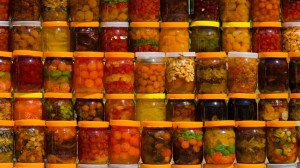Food preservation involves preventing the growth of bacteria, fungi (such as yeasts), or other micro-organisms as well as retarding the oxidation of fats that cause rancidity. Preservatives expands the shelf life of food and lengthen the time long enough for it to be harvested, processed, sold, and kept in the consumer’s home for a reasonable length of time. Maintaining or creating nutritional value, texture and flavor is an important aspect of food preservation.
Preservation has come from simple processes such as salting, to more complex preserving methods such as irradiation and chemical additives.
Salting draws moisture from meat through a process of osmosis. Meat is cured with salt or sugar. Nitrates and nitrites are also often used to cure meat and contribute to the characteristic pink color, as well as inhibition of Clostridium botulinum.
Drying is one of the most ancient techniques, which reduces water activity sufficiently to prevent bacterial growth. Freezing- commonly used processes for preserving a very wide range of food including prepared foodstuffs which would not have required freezing in their unprepared state.
Preservative food additives can be antimicrobial, which inhibit the growth of bacteria or fungi, including mold, or antioxidant, such as oxygen absorbers, which inhibit the oxidation of food constituents. Common antimicrobial preservatives include calcium propionate, sodium nitrate, sodium nitrite, sulfites (sulfur dioxide, sodium bisulfite, potassium hydrogen sulfite, etc.), and disodium EDTA. Antioxidants include BHA and BHT.
In conclusion, food preservation has been pivotal to our society since the beginning. Looking into the future, High Pressure Preservation seems to be the next logical step. In an increasingly health-conscious world, an uncontaminated, well preserved food source is the ultimate goal, and hopefully the costs of production will decrease for all of us to enjoy HPP foods.

